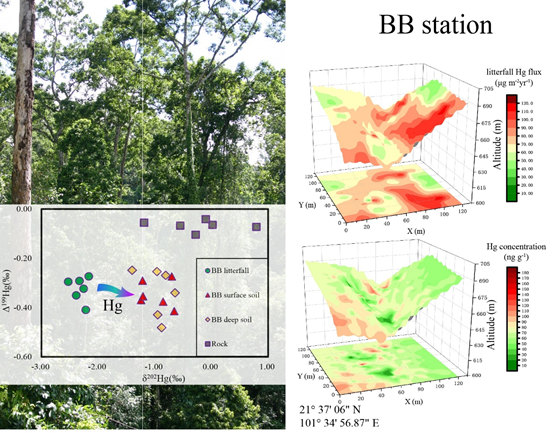As a global pollutant, mercury (Hg) is emitted directly into the atmosphere from geogenic and anthropogenic sources and previously deposited Hg in natural surfaces. Previous studies in subtropical evergreen forests have shown that climate, vegetation and terrain factors shape Hg accumulation in forest floor. However, few studies have conducted a comprehensive observation of Hg mass balance in tropical forests.
In a study published in Journal of Hazardous Materials, researchers from the Xishuangbanna Tropical Botanical Garden (XTBG) and the Institute of Geochemistry of the Chinese Academy of Sciences tried to explore Hg mass balance in tropical forests along a latitudinal gradient. They showed that the tropical forest at the lowest latitude has the highest litterfall Hg input but the smallest surface soil Hg concentration because the elevated microbial reduction processes induced Hg loss.
The researchers used 1-ha sampling plot, the most widespread method for forest inventory, to assess Hg spatial accumulation in tropical forests. They chose three typical tropical forests located in the transection region of tropical to subtropical zone in Southwest China to demonstrate the variation of Hg accumulation in soils in response to the change of climate and vegetation.
The soil Hg concentration showed an increasing trend along with latitudinal gradient in the three tropical forests. The tropical forest at the lowest latitude had the highest litterfall Hg input, but the smallest surface soil Hg concentration. Terrain and climate are main factors to drive the spatial distributions of tropical Hg.
They used Hg isotopic signatures to display post-depositional Hg processes in soils. The Hg isotopic evidence indicated that microbial reduction mainly contributed to tropical Hg loss and isotopic fractionation. The slower turnover of nutrients in high latitude tropical forests would enhance the Hg abiotic reductions which induced a small negative mass independent fraction shift in soils.
"Our study suggests that fast nutrient cycles in tropical forests possibly lead to a smaller atmospheric Hg net sink than in other forests," said Dr. XIA Shangwen of XTBG.







